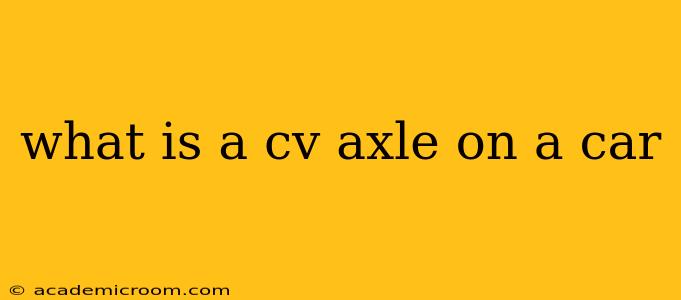A CV axle, short for constant velocity axle, is a crucial component in your car's drivetrain, responsible for transmitting power from the transmission to the wheels, especially in front-wheel-drive (FWD) vehicles and all-wheel-drive (AWD) vehicles. Unlike older vehicles with simpler drive shafts, CV axles are designed to handle the changing angles of the wheels during steering maneuvers, maintaining a constant rotational speed. This is vital for smooth operation and prevents the jarring or uneven power delivery that would occur with a fixed-angle drive shaft.
What are the main components of a CV Axle?
A CV axle consists of several key parts working in concert:
-
Axle Shaft: This is the main, long shaft that extends from the transmission to the wheel. It's typically made of strong, durable steel to withstand the stresses of transmitting engine power.
-
Constant Velocity (CV) Joints: These are the ingenious components that allow the axle to transmit power smoothly, even as the wheels turn. They consist of intricate ball bearings and cages that maintain constant rotational speed regardless of the axle's angle. Two CV joints are typically found on each axle – one near the transmission (inner CV joint) and one near the wheel (outer CV joint).
-
Boots (or gaiters): These rubber coverings protect the CV joints from dirt, water, and other debris. Their integrity is critical; damage to the boots can lead to joint failure.
-
Wheel Hub: The outer end of the CV axle connects directly to the wheel hub assembly.
How does a CV Axle work?
The brilliance of the CV axle lies in its CV joints. These joints employ a sophisticated system of precisely engineered ball bearings that allow the axle to rotate freely even while changing angles. As you turn the steering wheel, the angle of the wheel changes, and the CV joints effortlessly accommodate this change, ensuring smooth and constant power transfer to the wheel. This is in contrast to older vehicles, which used simpler systems that resulted in binding or uneven power distribution during turning.
What are the signs of a bad CV axle?
Several warning signs indicate that your CV axle may be failing or nearing the end of its lifespan:
-
Clicking or popping noises: These sounds, especially when turning, are a classic symptom of a failing CV joint. The noises stem from the internal components of the joint becoming worn or damaged.
-
Vibrations: A bad CV axle can cause vibrations felt in the steering wheel or throughout the vehicle, particularly at higher speeds.
-
Grease leaks: If you notice grease around the axle boots, this signals a potential breach in the boot's seal, allowing dirt and moisture to contaminate the CV joint.
-
Grinding or humming noises: These are often later-stage symptoms, indicating significant wear and tear on the joint.
How long do CV axles last?
The lifespan of a CV axle depends heavily on driving conditions, driving style, and vehicle maintenance. On average, CV axles can last between 50,000 and 100,000 miles, but this can vary significantly. Regular maintenance, including checking the boots for damage, goes a long way in extending their life.
Can I drive with a bad CV axle?
While you might be able to drive with a failing CV axle for a short period, it's strongly discouraged. Continuing to drive with a damaged axle can lead to further damage, potentially resulting in a complete axle failure, leaving you stranded. Repair or replacement should be done as soon as possible.
What causes CV axle failure?
CV axle failure is often caused by a combination of factors:
-
Wear and tear: Over time, the components within the CV joints wear down due to constant stress and use.
-
Damaged boots: A damaged or torn boot allows contaminants to enter the CV joint, accelerating wear and tear.
-
Driving style: Aggressive driving, including sharp turns and rapid acceleration, can put extra stress on the CV axles.
-
Poor road conditions: Driving on rough or uneven roads can also contribute to wear and tear.
This comprehensive guide provides a thorough understanding of CV axles and their importance in your vehicle's drivetrain. Remember, regular maintenance and prompt attention to warning signs can prevent costly repairs down the line.
